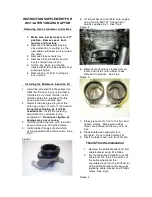
1
2
3
4
5
6
7
8
Starting and Driving
133
Shifting to Reverse Gear
Before shifting to the reverse gear, be
sure to stop the vehicle stably and
then fully press the clutch when the engine
is running at an idle speed, waiting a
moment (about 3 s) and then shifting to the
reverse gear.
Five-speed Transmission
Put the shift lever in Neutral position and
then move the shift lever to right until to the
end, and then move it back, at the moment
you can feel the reverse gear engaging, the
transmission will be shift to Reverse (R).
Six-speed Transmission
Place the shift lever in Neutral position and
then lift up the button indicated and simulta-
neously move the shift lever to right until to
the end, and then move it backward.
Only lift up the reverse button When
you want to shift into reverse posi-
tion.
Brake system
Service Brake
The braking operation time including detec-
tion time and reaction time. The detection
time refers to the time to make the decision
to press the brake pedal. The reaction time
refers to the actual time from lifting your feet
to press the pedal. The average reaction
time is about a three-quarter second. But
that is just average value. The reaction time
of a driver may be shorter, while that of
another driver is 2 to 3 seconds or longer.
The ages, physical condition, vigilance,
coordination and vision will affect the reac-
tion time. Alcohol, drugs and depression will
also have an impact on it. But even if the
reaction time is a three-quarter second, one
vehicle which travels at 100 kilometers per
hour will travel 20 meters in this reaction
time. In case of an emergency, it is a long
distance; therefore, it is important to keep
enough distance between your vehicle and
other vehicles. Without a doubt, the actual
braking distance, depending on the road
type (road or sand road), road condition
(wet, dry or frozen), tire pattern, the condi-
tion of brake, vehicle weight and the braking
force imposed, has a very big difference. It
is necessary to void unnecessary emer-
gency braking. Some people will drive in the
short and sudden way, suddenly accelerat-
ing and then emergency braking, rather
than being synchronous with traffic. This is
a wrong behavior. The brake may not have
enough time to cool down between several
emergency braking operations. Frequent
slamming on the brake pedal can acceler-
ate wear of brake. Being consistent with the
traffic speed and keeping a certain distance
will reduce a lot of unnecessary braking
operations. This means a better braking
and a longer service life of the brake. If the
















































